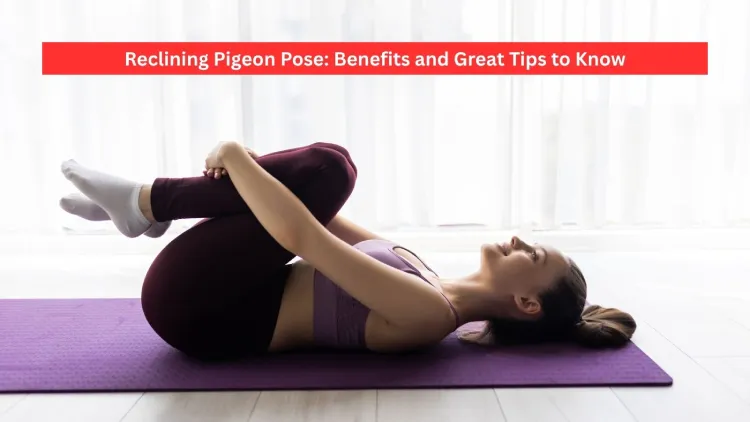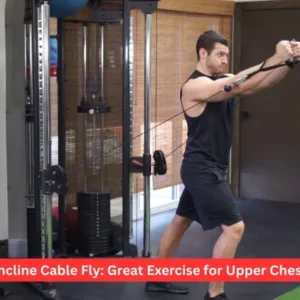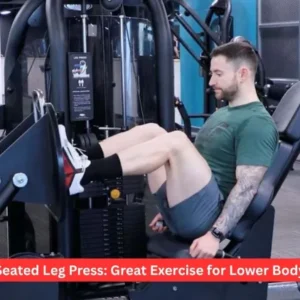Supta Kapotasana or the Reclining Pigeon Pose, is a figure-four stretch, or, more commonly, even The Figure Four Stretch, is an accessible and very helpful yoga position that can remove tension in the lower back, hips, and glutes. The alternative variation is more commonly practised by people with knee or hip issues because it can be easier and even safer to do in comparison to the traditional Pigeon Pose, as it represents a much-needed stretch without being that strenuous or even harmful at all to those concerned with such problems.
Whether you are an athlete, office worker, or person with tight hips and sciatic pains, the Reclining Pigeon Pose is an ultimate remedy to increase flexibility, alleviate lower back pain, and quiet the nervous system. Here is everything you need to know about this restorative pose, step by step, along with modifications and the potent physical and mental effects it has.
You will also get to know what the pitfalls of practising it are and what time is the most appropriate to practice it, as well as some precautions to guarantee both safety and comfort. Regardless of whether you are trying to use it during warm-ups, cooldowns, or just to relax every day, learning to use Reclining Pigeon Pose may be what makes the difference in your mobility and well-being.

What Is Reclining Pigeon Pose?
Reclining Pigeon Pose This is a restorative pose that opens the front of the hip and duplicates the structure of a conventional Pigeon Pose in a more available and supported position. On the back, the knees and the hips are put under less pressure, which is also the safest option to use for those who experience a mild form of joint pain or immobility.
This pose is a twisting of one ankle by the other thigh, and the supporting leg is tenderly pulled towards the chest. This makes a figure of four, which bleeds the deep muscles of the hips and glutes, particularly the piriformis, a small muscle resting against the sciatic nerve when it becomes tight.
Reclining Pigeon Pose is also a popular and ready-to-go stretch in physical therapy and in pilates, and during post-exercise exercises because it helps in increasing flexibility and reducing tension in the muscles.

Benefits of Reclining Pigeon Pose
The Reclining Pigeon Pose offers a great variety of physical and mental benefits. Being practised regularly, it can have an observable effect on the improvement of comfort, flexibility and the ability to reduce stress. The following are the most outstanding advantages:
1. Deep Hip Opening
Targeted hip muscle release is one of the major advantages of the Reclining Pigeon Pose. Most humans face hip stiffness on grounds of office jobs, driving or sitting. This pose relaxes the hip flexors and extends the swing to give the ability to walk, bend, adjust the stairs and perform other daily activities easily and in a comfortable way.
2. Stretch for Piriformis and Glutes
Behind those muscles is the piriformis muscle found in the deep buttocks that can become tight and lead to irritation of a nerve known as sciatic nerve. In Reclining Pigeon Pose, the piriformis and gluteal muscles are stretched, and this can lessen the pain of such discomforts as piriformis syndrome or mild sciatica.
3. Eases Lower Back Pain
As tight hips tend to pull the lower back and even lead to its misalignment, lower back tension can be decreased by stretching them with the help of the Reclining Pigeon Pose. This makes the pose particularly beneficial to those who have chronic back pain or those healing from lower back strain.
4. Enhances Blood Flow and Circulation
Both gentle pressure and pulling provide stimulation of circulation around the hip and pelvis areas. Addressed blood flow can eliminate the toxins in the tissues, accelerate the process of muscle recovery and improve joint health.
5. Calms the Nervous System
Reclining Pigeon Pose can help a person relax since it is a restorative yoga pose. When done intentionally and with slow, deep breaths, it triggers the parasympathetic nervous systemwhichhic is responsible for the restful and digestive functions of the body. This may alleviate stress, anxiety, and even allow one to have a restful sleep.
6. Improves Flexibility and Mobility
Reclining Pigeon Pose stretches several lower-body muscles simultaneously, so this pose also increases mobility over time. As time goes by, you will see how much freedom you have in your daily movements and improved alignment with all other yoga postures.

How to Do Reclining Pigeon Pose (Step-by-Step)
In order to experience all the benefits of the Reclining Pigeon Pose and yet not put an excessive strain, it is essential to learn how to perform it appropriately. Here goes the basic guideline on how you can do it safely and successfully:
Step 1: Lie Down
- This should be started by lying down on a mat or any other soft surface, flat on the ground, face up.
- Your knees should be in a low position with flat feet on the floor; the position of your feet should be separated by hip-width.
Step 2: Getting the Figure 4 position
- Raise your right foot and put your right ankle above your left thigh, above the knee.
- Your right knee will automatically swing to the side and be in a throwing motion, ctriangle-figures-fourourshape.
Step 3: Threads and Reach
- Stick your right hand through the gap between the legs and the left hand around the outer thigh.
- Take your left thigh with your two hands behind it (or your left shin if you want it to hurt more), and keeping one hand on the ground, pull your left leg up to your chest.
Step 4: Modify and Breathe
- Rest your head and your shoulders as they are on the floor.
- Make sure that you flex your right foot so as to protect your knee.
- Stay there and hold the stretch between 30 seconds a 1 minute with deep and even breathing.
Step 5: Let release / Switch
- Gradually come out of the stretch and put both feet back on the mat.
- Do the same on the other side.
The pose works best when one engages it regularly, even in a little quantity every dayy.
Modifications and Variations
Reclining Pigeon Pose is extremely popular because it is versatile. Not tight in the hips? Not hyper-flexible? It does not matter; there is something for you.
For Beginners:
- Should you struggle to touch your spine behind the thigh, a yoga strap, a towel, or a resistance band can help you do this.
- Put the floor between the grounded foot and the raised knee and press the knee to the floor with your hand.
To Intermediate to Advanced:
- To further stretch it, just pull the supporting leg to the chest.
- Push on the inner thigh of the bent leg with your elbow to open the hip more.
Seated Variation:
- This comfortable stretch may be in an office chair, which makes the Seated Figure Four Stretch a suitable one during breaks or for individuals with limited mobility.
- Sit up with your spine straight, and cross one ankle over the other knee and bend forward at the hips a little bit.
These variations enable each person to enjoy the Reclining Pigeon Pose according to his or her degree of flexibility and comfort.

Common Mistakes to Avoid
To bring the Reclining Pigeon Pose safely and successfully, the following are the mistakes to be avoided:
1. Upper body Tension
You can also tighten your muscles, raise your shoulders, or clench your jaw, which can cause additional stress. Engage your upper body to be loose and relaxed in the entire pose.
2. No Toes Up
That foot which is on the opposite thigh is always to be flexed. This engages the muscles of the knee and thereby helps prevent straining or twisting the knee.
3. Overstretching
One should not overstretch. Take it easy, particularly at the knees or lower back, when you develop stinging pain. Some mild pain is fine, but pain is a sign.
4. Holding the breath.
A lot of times, people hold their breath while they stretch. Concentrate on taking slow, deep breaths to release body tension.
When to Practice Reclining Pigeon Pose
It is the versatile nature of Reclining Pigeon Pose that makes it go without saying, truly beautiful. It can become a part of various activities of your everyday life:
- Morning Stretch: This stretch gently wakes your hips and the spine.
- Pre-exercise: Relax tight glutes and hip flexors, and be ready before the exercises.
- Post Exercise: It can be used to help cool down after running and weight training, or when you are cycling.
- Evening Wind-Down: Add it to your bedtime yoga routine to engage in relaxation.
Even though doing Reclining Pigeon Pose now and then, Ian is still creating long-term effects on your joints and muscles.
Tips for a Better Practice
- Take Props: Place a Yoga block or cushion under the head or lower back to get extra comfort.
- Warm Up First: Straightforward stretches such as Cat-Cow or Supine Twist are excellent for warming up the body.
- Be Committed: The actual rewards of Pigeon Pose and Reclining depend on constant practice.
- Remember to be mindful: Uniting the breath with the movement is one of the ways to relax physically and mentally.

Final Thoughts
The Reclining Pigeon Pose is one of the most effective yet harmless poses that has many physical and emotional advantages. With a practice of practising it orregularlyou will be able to alleviate the strain on your hips, lower back, increase flexibility, and bring peace to your mind. This pose can be practised by individuals who cannot execute more complex hip openers because it is doable, injury-free, and versatile.
After a long day, you may want to use the Reclining Pigeon Pose to ease yourself, but before exercise, it can be a great warm-up exercise as well as a powerful mobility, recovery, and restorative activity! All one needs is some silent time on the mat that would rejuvenate the inner being.
Frequently Asked Questions
Does sciatica benefit the Reclining Pigeon Pose?
Yes, Reclining Pigeon Pose is considered to be among the most suggested stretching exercises for sciatic pain management, and it is particularly effective when the sciatica is the result of piriformis syndrome. This pose relieves sciatic nerve pressure by stretching the piriformis and glute muscles amiably and offers relief and better mobility.
Is the Reclining Pigeon Pose safe to do by a beginner?
Absolutely. The Reclining Pigeon Pose would be the best one performed as it is lying, so the stress on the knees and hips cannot possibly be developed. Adjustments like the use of a yoga strap or the supporting foot on the ground make it more accommodating to less flexible people.
What is the duration that I am supposed to take in Reclining Pigeon Pose?
To get maximum benefit, maintain the Reclining Pigeon Pose on both sides in a 30-second to 1-minute period. Withhold and concentrate on breathing continuously, and slowly intensify the position without pushing. With time, you may increase the hold to 2 minutes as flexibility through the hold increases.
What is the best time to observe the Reclining Pigeon Pose?
The use of Reclining Pigeon Pose can be done at any time of the day. It is awesome any time in the morning to open the hips, before or after any type of exercise to bring some stretch to the body and to relax the muscles, or in the evening to allow the body to release as a cooling off point.







